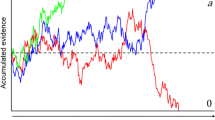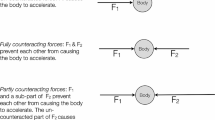Abstract
The ability to predict accurately the weights of objects is essential for skilled and dexterous manipulation. A potentially important source of information about object weight is through the observation of other people lifting objects. Here, we tested the hypothesis that when watching an actor lift an object, people naturally learn the object’s weight and use this information to scale forces when they subsequently lift the object themselves. Participants repeatedly lifted an object in turn with an actor. Object weight unpredictably changed between 2 and 7 N every 5th to 9th of the actor’s lifts, and the weight lifted by the participant always matched that previously lifted by the actor. Even though the participants were uninformed about the structure of the experiment, they appropriately adapted their lifting force in the first trial after a weight change. Thus, participants updated their internal representation about the object’s weight, for use in action, when watching a single lift performed by the actor. This ability presumably involves the comparison of predicted and actual sensory information related to actor’s actions, a comparison process that is also fundamental in action.






Similar content being viewed by others
References
Aglioti SM, Cesari P, Romani M, Urgesi C (2008) Action anticipation and motor resonance in elite basketball players. Nat Neurosci 11:1109–1116
Alaerts K, Senot P, Swinnen SP, Craighero L, Wenderoth N, Fadiga L (2010a) Force requirements of observed object lifting are encoded by the observer’s motor system: a TMS study. Eur J Neurosci 31:1144–1153
Alaerts K, Swinnen SP, Wenderoth N (2010b) Observing how others lift light or heavy objects: which visual cues mediate the encoding of muscular force in the primary motor cortex? Neuropsychologia 48:2082–2090
Baugh LA, Kao M, Johansson RS, Flanagan JR (2012) Material Evidence- interaction of well-learned priors and sensorimotor memory when lifting objects. J Neurophysiol 108:1262–1269
Bingham GP (1987) Kinematic form and scaling: further investigations on the visual perception of lifted weight. J Exp Psychol Hum Percept Perform 13:155–177
Brass M, Schmitt RM, Spengler S, Gergely G (2007) Investigating action understanding: inferential processes versus action simulation. Curr Biol 17:2117–2121
Braun DA, Aertsen A, Wolpert DM, Mehring C (2009) Motor task variation induces structural learning. Curr Biol 19:352–357
Braun DA, Waldert S, Aertsen A, Wolpert DM, Mehring C (2010) Structure learning in a sensorimotor association task. PLoS One 5:e8973
Brown LE, Wilson ET, Obhi SS, Gribble PL (2010) Effect of trial order and error magnitude on motor learning by observing. J Neurophysiol 104:1409–1416
Falck-Ytter T, Gredeback G, von Hofsten C (2006) Infants predict other people’s action goals. Nat Neurosci 9:878–879
Flanagan JR, Beltzner MA (2000) Independence of perceptual and sensorimotor predictions in the size-weight illusion. Nat Neurosci 3:737–741
Flanagan JR, Johansson RS (2003) Action plans used in action observation. Nature 424:769–771
Flanagan JR, Wing AM (1997) The role of internal models in motion planning and control: evidence from grip force adjustments during movements of hand-held loads. J Neurosci 17:1519–1528
Flanagan JR, Bowman MC, Johansson RS (2006) Control strategies in object manipulation tasks. Curr Opin Neurobiol 16:650–659
Flanagan JR, Bittner JP, Johansson RS (2008) Experience can change distinct size-weight priors engaged in lifting objects and judging their weights. Curr Biol 18:1742–1747
Gordon AM, Westling G, Cole KJ, Johansson RS (1993) Memory representations underlying motor commands used during manipulation of common and novel objects. J Neurophysiol 69:1789–1796
Hamilton AF, Joyce DW, Flanagan JR, Frith CD, Wolpert DM (2007) Kinematic cues in perceptual weight judgement and their origins in box lifting. Psychol Res 71:13–21
Hesse MD, Sparing R, Fink GR (2009) End or means–the “what” and “how” of observed intentional actions. J Cogn Neurosci 21:776–790
Heyes CM, Foster CL (2002) Motor learning by observation: evidence from a serial reaction time task. Q J Exp Psychol A 55:593–607
Iacoboni M, Woods RP, Brass M, Bekkering H, Mazziotta JC, Rizzolatti G (1999) Cortical mechanisms of human imitation. Science 286:2526–2528
Iacoboni M, Koski LM, Brass M, Bekkering H, Woods RP, Dubeau MC, Mazziotta JC, Rizzolatti G (2001) Reafferent copies of imitated actions in the right superior temporal cortex. Proc Natl Acad Sci USA 98:13995–13999
Ingram JN, Howard IS, Flanagan JR, Wolpert DM (2010) Multiple grasp-specific representations of tool dynamics mediate skillful manipulation. Curr Biol 20:618–623
Johansson RS, Flanagan JR (2009) Coding and use of tactile signals from the fingertips in object manipulation tasks. Nat Rev Neurosci 10:345–359
Johansson RS, Westling G (1988) Coordinated isometric muscle commands adequately and erroneously programmed for the weight during lifting task with precision grip. Exp Brain Res 71:59–71
Lackner JR, DiZio P (2005) Motor control and learning in altered dynamic environments. Curr Opin Neurobiol 15:653–659
Land MF, Furneaux S (1997) The knowledge base of the oculomotor system. Philos Trans R Soc Lond B Biol Sci 352:1231–1239
Malfait N, Valyear KF, Culham JC, Anton JL, Brown LE, Gribble PL (2010) fMRI activation during observation of others’ reach errors. Journal of Cogn Neurosci 22:1493–1503
Mattar AA, Gribble PL (2005) Motor learning by observing. Neuron 46:153–160
Meulenbroek RG, Bosga J, Hulstijn M, Miedl S (2007) Joint-action coordination in transferring objects. Exp Brain Res 180:333–343
Oztop E, Wolpert D, Kawato M (2005) Mental state inference using visual control parameters. Brain Res Cogn Brain Res 22:129–151
Rizzolatti G, Craighero L (2004) The mirror-neuron system. Annu Rev Neurosci 27:169–192
Rizzolatti G, Fabbri-Destro M (2008) The mirror system and its role in social cognition. Curr Opin Neurobiol 18:179–184
Rizzolatti G, Fogassi L, Gallese V (2001) Neurophysiological mechanisms underlying the understanding and imitation of action. Nat Rev Neurosci 2:661–670
Rotman G, Troje NF, Johansson RS, Flanagan JR (2006) Eye movements when observing predictable and unpredictable actions. J Neurophysiol 96:1358–1369
Runeson S, Frykholm G (1981) Visual perception of lifted weight. J Exp Psychol 7:733–740
Shadmehr R, Smith MA, Krakauer JW (2010) Error correction, sensory prediction, and adaptation in motor control. Annu Rev Neurosci 33:89–108
Shim J, Carlton LG (1997) Perception of kinematic characteristics in the motion of lifted weight. J Mot Behav 29:131–146
Torriero S, Oliveri M, Koch G, Caltagirone C, Petrosini L (2007) The what and how of observational learning. J Cogn Neurosci 19:1656–1663
Webb A, Knott A, Macaskill MR (2010) Eye movements during transitive action observation have sequential structure. Acta Psychol (Amst) 133:51–56
Westling G, Johansson RS (1987) Responses in glabrous skin mechanoreceptors during precision grip in humans. Exp Brain Res 66:128–140
Wolpert DM, Flanagan JR (2001) Motor prediction. Curr Biol 11:R729–R732
Wolpert DM, Flanagan JR (2010) Motor learning. Curr Biol 20:R467–R472
Wolpert DM, Ghahramani Z, Flanagan JR (2001) Perspectives and problems in motor learning. Trends Cogn Sci 5:487–494
Wolpert DM, Doya K, Kawato M (2003) A unifying computational framework for motor control and social interaction. Philos Trans R Soc Lond Ser B Biol Sci 358:593–602
Acknowledgments
This work was supported by a grant from the Canadian Institutes of Health Research, the Swedish Research Council Project 08667, and the Strategic Research Program in Neuroscience at the Karolinska Institute. We would like to thank Sean Hickman and Martin York for technical support.
Author information
Authors and Affiliations
Corresponding author
Rights and permissions
About this article
Cite this article
Reichelt, A.F., Ash, A.M., Baugh, L.A. et al. Adaptation of lift forces in object manipulation through action observation. Exp Brain Res 228, 221–234 (2013). https://doi.org/10.1007/s00221-013-3554-9
Received:
Accepted:
Published:
Issue Date:
DOI: https://doi.org/10.1007/s00221-013-3554-9




